The IFAK (individual first aid kit) has become extremely popular. A number of companies sell purpose-built, military-style IFAKs for civilian use. Many more sell IFAK components. Numerous methods of carry, including wallet kits and ankle rigs have proliferated. I think that’s fantastic. Unfortunately I think the twin Gospels of the Tourniquet and the IFAK aren’t the end of the story as far as first aid for the well-prepared is concerned.
My articles often contain affiliate links. Because of the high incidence of counterfeit medical products on Amazon.com, this article contains no affiliate links whatsoever.
Disclaimers and Caveats
Nothing I say in this article should be construed as medical advice. I’m just some dude on the internet. I’m not a doctor, I’m not qualified to teach anything medical, and I’m not telling you how to treat anything. Descriptions of tools here are merely that, not instructions on how to use them. I’m certainly not telling you to forgo medical providers and practice DIY medicine – if you need emergency medical services, a doctor, or the support of a hospital, you should seek those things out.
But as adults we all realize that sometimes bad things happen. Sometimes we have to rely on ourselves, no matter how much we might want or how hard we might seek a healthcare professional. This article merely covers the baseline equipment I would want to have on hand for such an emergency.
Also please note that equipment is almost worthless without training. More importantly, the equipment mentioned here can be dangerous if used incorrectly. I will repeat this over and over again in this article, but you need to seek medical training. Even if you completely ignore my equipment advice, please seek high quality medical training.
The Individual First Aid Kit
The IFAK as we know it was designed for use on the battlefield. The core components of the basic IFAK are the tourniquet, the battle dressing, an occlusive dressing, and perhaps a hemostatic agent. An expanded IFAK may have a couple of other respiratory/airway interventions such as a nasopharyngeal airway (NPA) device, and a catheter for performing a needle decompression. The design and inclusion of these tools in the IFAK was a direct response to battlefield mechanisms of injury.
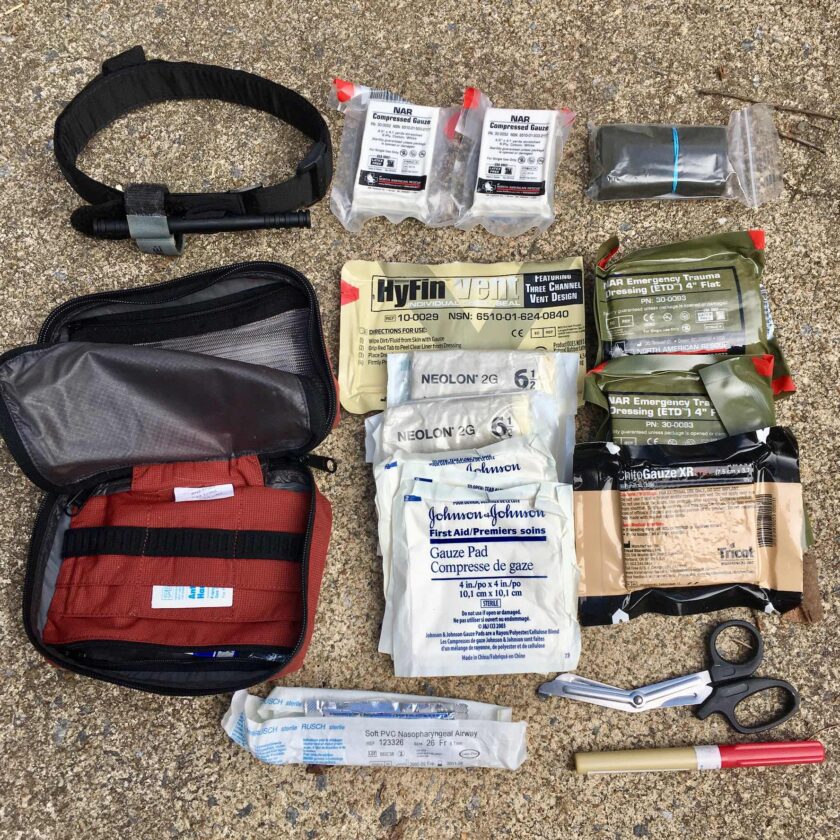
The battlefield dressing and tourniquet were fielded to deal with preventable exsanguination (bleeding out) from extremity wounds. Since the advent of ubiquitous body armor and effective helmets, wounds that normally would have been suffered by vital organs and were now stopped by the armor. This meant an increase in deaths from extremity wounds, an insult that the tourniquet has been incredibly effective at preventing.
Widespread fielding of hemostatic agents was intended to deal with hemorrhage in junctional areas, the high-femoral bleed made famous by the film Blackhawk Down. The chest seal was designed to deal with punctures to the thoracic cavity, preventing death from tension pneumothorax. Finally, nasopharyngeal airways and decompression needles gave soldiers the ability to deal with some other respiratory problems common to battlefield injuries. The NPA maintained airway patency while the needle could relieve a tension preumothorax.
Problem with the IFAK Model
The IFAK has saved untold thousands of lives on the battlefield. Without a doubt the IFAK – or selectively carried IFAK components like the tourniquet – have saved quite a few lives in non-military contexts, as well. But it’s not a perfect model and it’s not the last word in medical components for those seeking to be prepared against whatever may come. There are two problems with the IFAK model.
The first is that the injuries covered by the IFAK are very limited in scope. The IFAK is heavily geared toward trauma, specifically battlefield trauma. This makes sense considering it was developed by the military. Unfortunately the IFAK and “combat trauma”-oriented classes completely fail to address many injuries, illnesses, and insults that are massively more common than gunshots or roadside bombs.
CPR is an awesome example: CPR is not taught in Tactical Combat Casualty Care (TCCC). This makes sense; cardiac arrest caused by traumatic injury or hypovolemia secondary to trauma is not generally correctable with CPR. Even it if were, CPR is impractical on the battlefield, and takes soldiers’ focus away from their primary task: returning fire. I think this has made CPR sort of “uncool” and overlooked, but high-quality CPR saves countless lives. When your parent, spouse, or child goes into respiratory distress it won’t matter that the “cool guys” don’t worry about CPR.
Second, the IFAK is heavily geared toward treating very healthy, military-aged personnel. This ignores a huge swath of the population: pediatrics and older adults. Even if you aren’t a healthcare provider, my guess is that there are some pediatrics and geriatrics in your life that you care about. The problems they are mostly likely to suffer probably aren’t traumatic amputations or, gunshots, or blast injuries.
Third, IFAK components are designed to be as compact and lightweight as possible. That excludes a lot of other really important equipment that, again, you’re probably more likely to need than a tourniquet. I’m not saying you shouldn’t have the components of an IFAK, but you also shouldn’t stop there. In a home first aid kit you are unconstrained by size, so use that to your advantage. Sometimes bulkier, heavier, non-IFAK items are cheaper just because they don’t have to be designed to withstand daily carry by a soldier.
Why Does This Matter?
Why should you invest in home first aid equipment? Why not just call EMS?
Even the most level-headed among us have acknowledged that sometimes, under some conditions, we may not have the luxury of a dozen police officers with lights and sirens at our beck and call. Like Chris, I don’t mean to be alarmist, but I am obviously a firm proponent of resilience. I advocate a strong lack of dependence on external sources of support. If you carry a gun you should already understand where I’m going with this. You’ve probably heard (or maybe even said) something along the lines of:
“When seconds count, the police are only minutes away”
This statement (and many, many more like it) is an acknowledgement that emergency services might not always be at our fingertips. I get it – guns are cooler and more fun that bandages. It’s way sexier to fantasize about being in a gunfight than about your wife having a heart attack. But, if you acknowledge that police can’t always be available, you should also acknowledge that EMS personnel may not always be available, either. EMS resources are not unlimited.
My county for instance, encompasses over 550 square miles and contains over 60,000 people. Providing coverage for all that area and all those people are just eight ambulances and crews. There are a couple more volunteer ambulances that can be put on the road in a pinch, but that only puts the total up to ten, or one ambulance per 6,000+ people. That probably doesn’t sound too bad, but even during “normal” times we occasionally “run out” of trucks (i.e., they’re all, simultaneously, somewhere in the process of responding to a call).
In major metropolitan areas the number of trucks per person is generally smaller. Because big-city ambulances have such short transport times to hospitals relative to rural areas, they can get by on fewer per capita. Why is coverage spread so thin? Ambulances are expensive. The stuff inside ambulances – like cardiac monitors, ventilators, and CPAP machines – is expensive. Maintaining ambulances in safe, working order is expensive. Medications are insanely expensive, and they expire and must be replaced. Paramedics and EMTs must be paid salaries and given benefits. As a taxpayer you probably wouldn’t be too happy if your city or county was maintaining and staffing twice the ambulances it needed on the average day.
So, when things happen that require resources above and beyond the normal? Service can be delayed. It can be delayed by a little, or by a lot. Even if there is an abundance of trucks on the road, things can happen that prevent them from getting to you. There are plenty of stories of critically ill or injured people being cut off from support by extreme weather. Riots may delay arrival times significantly. Wildfires, earthquakes… I could go on and on, but you probably get the idea.
Be Your Own Emergency Provider
You should be prepared to be your own emergency healthcare provider, at least for a short duration. The primary method of being prepared – in any avenue, not just medical skills – is in training. Training, training, training, and more training, supplemented by some experience. I can’t say that enough – all the equipment in the world won’t save you if you don’t know how to use it. If you don’t have training, you probably don’t know how to use it.
I have advocated strongly for becoming an EMT-B. I think everyone with any interest whatsoever in preparedness should highly prioritize seeking this training and credential. If you can’t set aside the time to attend EMT (and I realize that many people cannot) you should, at an absolute minimum, seek out Red Cross CPR, First Aid, and a Tactical Combat Casualty Care (TCCC) class.
These are a very basic minimum but if you’re interested in saving your own life or lives of your family (as your carry of a firearm would indicate) you should aggressively pursue first aid training. I’ll warn you now: I’m going to admonish you constantly throughout the remainder of this article to get training.
With all that out of the way, let’s finally get into the topic of this article: the stuff that I think you should have in a home first aid kit.
Minor Cuts and Abrasions
Though not included in most IFAKs (mine is an exception) you should definitely have the tools to deal with minor cuts and abrasions. These little things are annoying. They bleed and get messy, and slow you down in the performance of normal, day-to-day tasks. In a long-term survival situation, they can also become life-threats by becoming infected; this is not a concern in the context we’re discussing (preparing for prolonged EMS response times) but should certainly be a concern for those interested in being prepared. We aren’t too worried about long-term stuff in this article, but it should be in your awareness.
You don’t need a whole lot to treat minor cuts and scrapes. Some adhesive bandages and antibiotic ointment will do it. We keep variously sized adhesive bandages around. With all the outdoor work and play we do, we get a LOT of minor cuts and scrapes and have a lot of opportunity to test bandages. I think this is an area where buying quality really matters; the actual Band-Aid brand bandages work much better than just about any store-brand alternative we’ve tried. Our kits also contain plenty of Steri-Strips. These adhesive strips work for temporarily closing larger lacerations.
One of the pearls from Greg Ellifritz’ Tactical First Aid/Collapse Medicine (which my girlfriend and I have attended) was that double antibiotic ointment is usually preferable to triple antibiotic ointment. Triple antibiotic ointment (Neosporin) contain Neomycin. As much as 10% of the population is allergic to Neomycin. This usually just presents as redness around the application, but reactions can be much more severe. We have switched to double antibiotic ointment, sometimes sold as “polysporin.” If you don’t have any of either, soap and water is probably better than either, anyway.
I listed this first because it is, overwhelmingly, the section you will use the most. Hopefully it is the only section you will ever use. Now we will delve into true emergency supplies.
Airway
Airway emergencies are dire. You can’t survive very long without breathing. Brain and cardiac tissue are extremely sensitive to oxygen deficits. Irreversible brain damage can begin in as little as three minutes after a person stops breathing. If a loved one stops breathing, it will very well take much more than three minutes for an ambulance to arrive, even in the best of times.
Airway stuff isn’t cool, most of it isn’t high-speed “care under fire” stuff but it’s very, very important. There is no way I would be without the tools to provide my family members with an airway. The stuff listed here are tools to help you keep an airway patent (clear and unobstructed).
Airway adjuncts are tools that help you keep a person’s airway clear. Just as important as tools is technique; many an airway can be cleared by knowing how to safely position a person’s head. Again, I can’t stress the importance of training enough; there is one technique (the jaw thrust) that is used when injuries to the cervical spine cannot be ruled out. Using the other technique (the head tilt/chin lift) in the wrong instance can cause or exacerbate a devastating spinal injury.
Airway adjuncts can help you by clearing the airway and keeping it clear while you do other things. This is extremely important if you’re providing respirations for someone by yourself, and helpful even if you are aided by another person.
The first airway adjunct is the nasopharyngeal airway (NPA). Sometimes called the “nasal trumpet” or the “nose hose,” it is nothing more than a soft, flexible tube that is inserted into one’s nasal passage and into the pharynx. This allows air to pass and bypasses obstructions like blood, snot, etc. It’s not a definitive airway and it won’t prevent the aspiration of blood or vomit, but it’s much better than nothing.
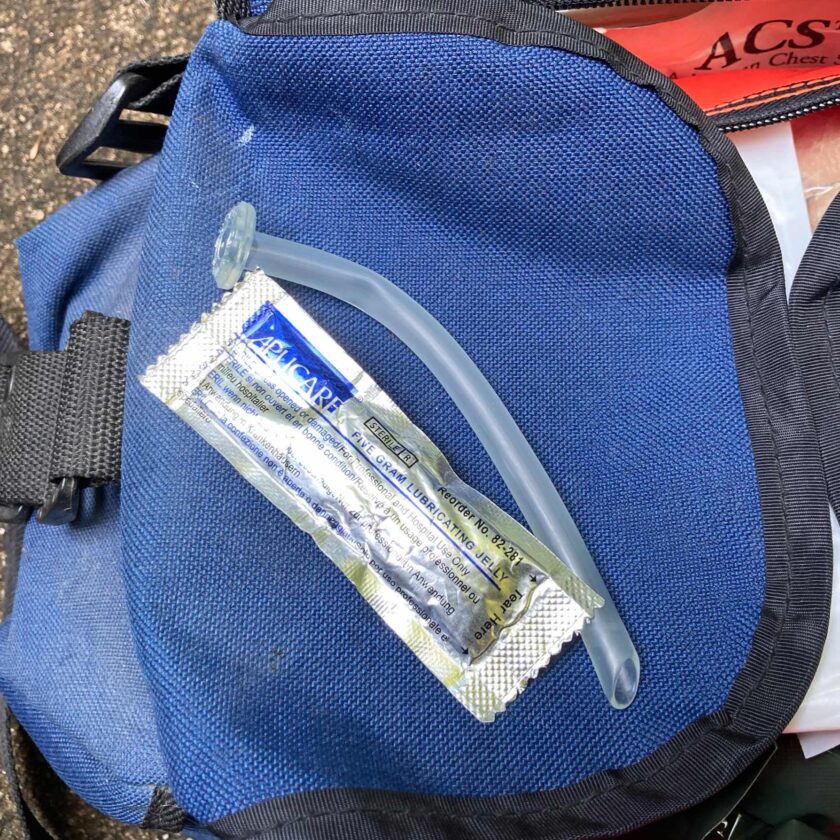
If I had to pick one airway adjunct, it would the NPA. It can be used most of the time instead of a oropharyngeal airway (OPA) which we’ll discuss in a minute. The reason? It’s rarely contraindicated (most importantly in the case of potential skull fracture) and is usually tolerated much better than an OPA. Many people with an IFAK already possess a nasopharyngeal airway. What you probably don’t own is various sizes of NPAs. Your great, big adult-sized nose hose probably isn’t going to fit your infant daughter too well. I recommend purchasing a variety of sizes of NPAs (six sizes usually runs $30).
I strongly recommend ensuring you have some lube handy, along with your NPAs. I’m sure someone reading this has heard an instructor say, “the operator feels no pain,” or “use their blood,” or something along those lines. Using their blood might work…assuming they are bleeding. If your 8-year old son goes into respiratory arrest in your home, it’s probably not because he has just been in an IED blast, and he’s probably not bleeding. But he might be if you cram a NPA into the delicate mucous membrane of his nose. This is going to cause the additional problem of blood in his airway, so head this off by lubing the damn thing.
Next up is the oropharyngeal airway (OPA). I recommend these somewhat hesitantly for home use. You really need to know what you’re doing with OPAs, even though they aren’t difficult to put into play. Most importantly, you need to know when NOT to use them. OPAs are contraindicated anytime the patient has an intact gag reflex. They’ll puke, then you’ll have all sorts of fluid and solid matter in their airway which just made your situation way, way, WAY worse. I cant’ stress enough the importance of training.
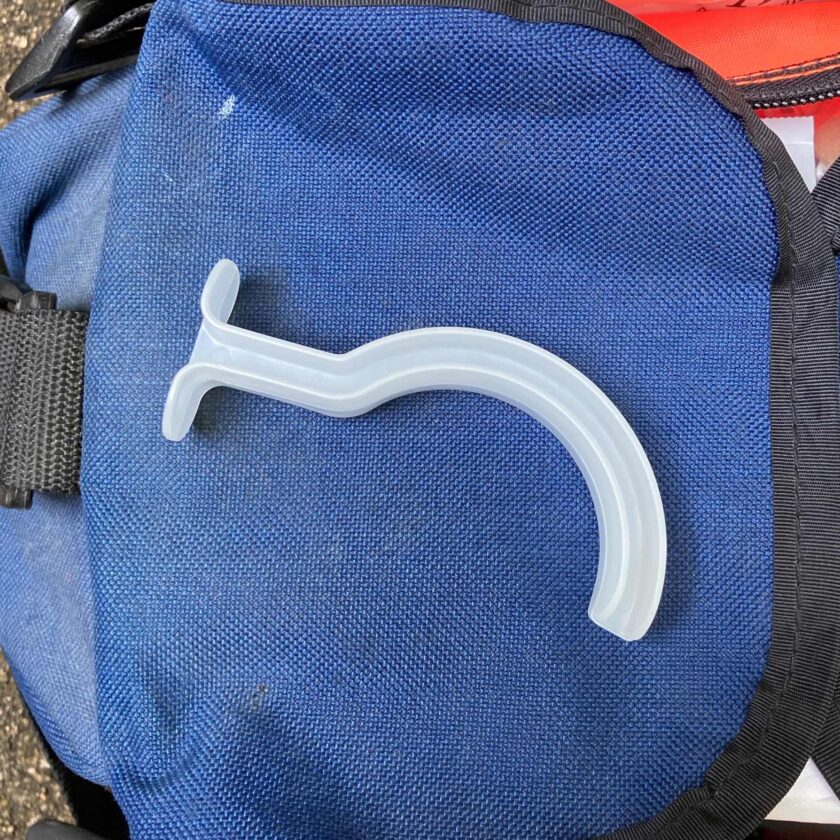
I would have some OPAs on hand and know how to use them (can I beat this dead horse enough?) because they do an excellent job of keeping the tongue out of the back of the airway. These aren’t one-size-fits-all (and sizing them to the patient is another skill that training will provide). Good news, though: a set of six sizes from adult to pediatric will set you back less than $10.
Respirations
Establishing a patent airway is important. Often, just correctly positioning the head and opening the airway will solve the respiratory problem, at least in the immediacy. But not always; it is also important to be able to circulate air in and out once an airway is established. As with most medical interventions, knowledge and training are required. Force too much air into a person’s lungs and you’ve just created a very big, potentially life-threatening problem for them.
A CPR mask is the baseline intervention here. Get a good one with a nice, air-filled gasket around the rim. That will allow it to adjust to the contours of the patient’s face and maintain an air-tight seal. Also make sure your mask has a one-way valve; people receiving ventilations often vomit. You definitely don’t want that coming back into your mouth. Personally, I would never recommend using a mouth-to-mask technique on anyone you don’t know and love, but we are talking about taking care of your family here.
If you have the training to use one, it probably wouldn’t be a bad idea to have a bag valve mask. I don’t own one, but in conducting an inventory of my home medical capability recently, I realized that I want one. Actually, I want two: an adult and a pediatric. I will be adding these to my capability very soon. Again, seek training before you run out and purchase a tool like this; the misuse of a BVM can cause barotrauma (pressure injury to the lungs) and make matters much, much worse for the patient.
I would also recommend a chest seal. Though I have a bunch of old Asherman Chest Seals from back in the day, I really like the newer HyFin vent. These occlude injuries to the chest and abdomen, but let air out if necessary. They are much stickier and generally better than the older Asherman. I recommend having two (they are sold individually or in a twin pack) so you can place one on the entrance and one of the exit, if applicable. You can also use cheaper solutions, like petroleum gauze.
Major Bleeding
You absolutely need a way to control major bleeding in your home first aid kit. The things that we do around the house that have the potential to cause major bleeding include using a chainsaw, kitchen knives, firearms, table and circular saws, lawn mowers… We’re very careful, but we also acknowledge that bad things happen.
Of course tourniquets are important, and there are two in my home first aid kit (CAT, Gen7). Tourniquets are fantastic for stopping extremity bleeds. I would have at least two because a.) you may have more than one injured extremity, and b.) on very large limbs (usually legs) it may take two tourniquets to fully occlude the artery. Unfortunately, tourniquets only cover down on extremity bleeding; a tourniquet will do nothing for bleeding on the neck, torso, or head (a pretty significant percentage of your overall body). It’s a good idea to have some other options available.
Hemostatic agents are chemical compounds that stop bleeding through some sort of chemical reaction (the specifics of the various products vary). These products are known under various trade names like Quik-Clot, ChitoGauze (my preference), and Celox. As mentioned earlier, these were fielded to deal with junctional bleeds, such as the high femoral artery. Unlike the early Quik-Clot, most of these agents are now impregnated into gauze rather than fielded as a pouch of powder. Also unlike Quik-Clot, these substances no longer create intense heat upon activation.
Honestly, in a home kit this wouldn’t be my top priority as quality hemostatic agents are very expensive, specialty items. If you have the money, get a good one. I highly recommend you seek training on these tools rather than simply relying on the idea that when the time comes, you’ll figure it out.
For bleeding that doesn’t require a tourniquet or a hemostatic agent, there is the good, ol’ pressure dressing. You may know them as the “Israeli dressing” or “battle dressing.” These have come a very, very long way in the past couple of decades. Though made by a variety of manufacturers, most have some sort of thick, absorbent pad that goes over the wound, and a long, elastic bandage that tightens over it. Some of the top brands are NA Rescue, H&H, and OLAES, and these are available in a variety of sizes. Training will help you decide which one you prefer.
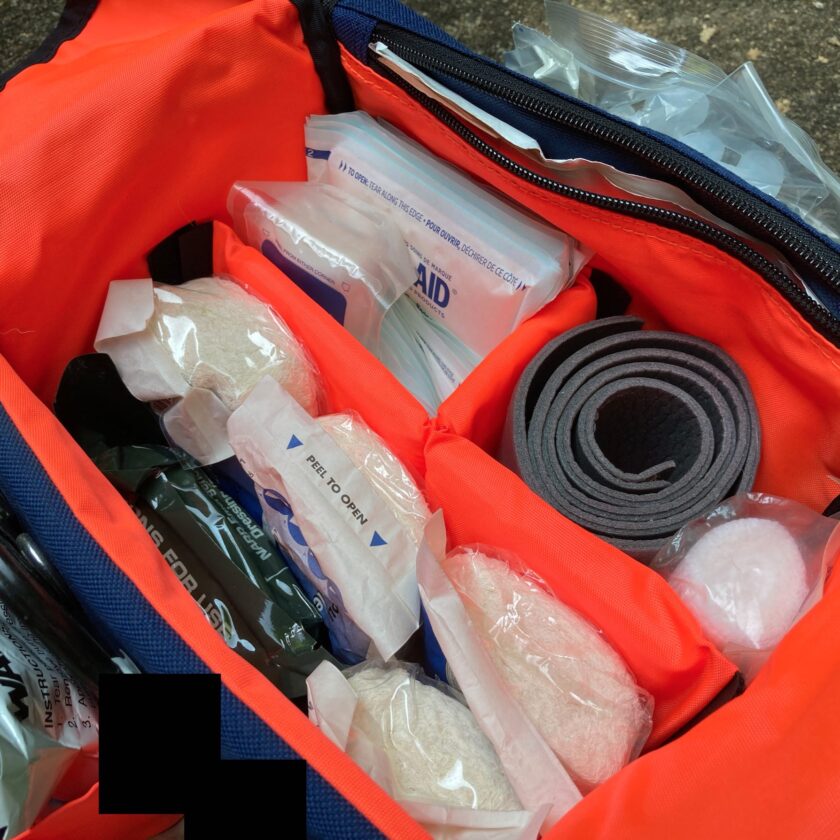
Tourniquets, hemostatic agents, and pressure dressings are awesome. However, I would also recommend having some good, old fashioned 4×4 gauze pads and 4″ roller gauze. I really don’t want to use an $8 pressure dressing or $40 hemostatic agent for something that is too big for a Band-Aid, but that doesn’t require such an intervention. A box of 50 sterile 4x4s and a dozen rolls of 4″ sterile gauze will set you back less than $25, will cover a huge array of injuries, and you can buy it at your local CVS or Walgreens. Again, this isn’t “cool guy” medical kit, but 4x4s and roller gauze are the backbone of trauma management.
Orthopedic Injuries
Tactical medicine and care under fire completely ignore orthopedic injuries like sprains, dislocations, and and broken bones. This is for good reason – caring for them would be impractical under fire. If your wife falls and dislocates her shoulder are you going to tell her that, “we don’t treat dislocations under fire. Good luck!”?
You aren’t going to be able to repair broken bones at home. However, you can keep the victim as comfortable as possible and, more importantly, prevent further injury by immobilizing them. There are two tools that I would absolutely keep on hand.
The first is a good supply of cravats (triangular bandages). I have them stuffed everywhere; they are incredibly versatile. A cravat can be folded into a wide band used to strap one leg to the other. Two of them can be fashioned into a sling and swath to immobilize an arm. It can be folded into a band to tie a pillow around a foot to immobilize it. There are probably two dozen other ways triangular bandages can be used. Since there really isn’t much too them, I wouldn’t mind getting a bunch of the cheapest ones you can find on Amazon (I found a box of 12 for $8 on Amazon) or at your local drug store. For my backcountry kit I would definitely have good ones, though.
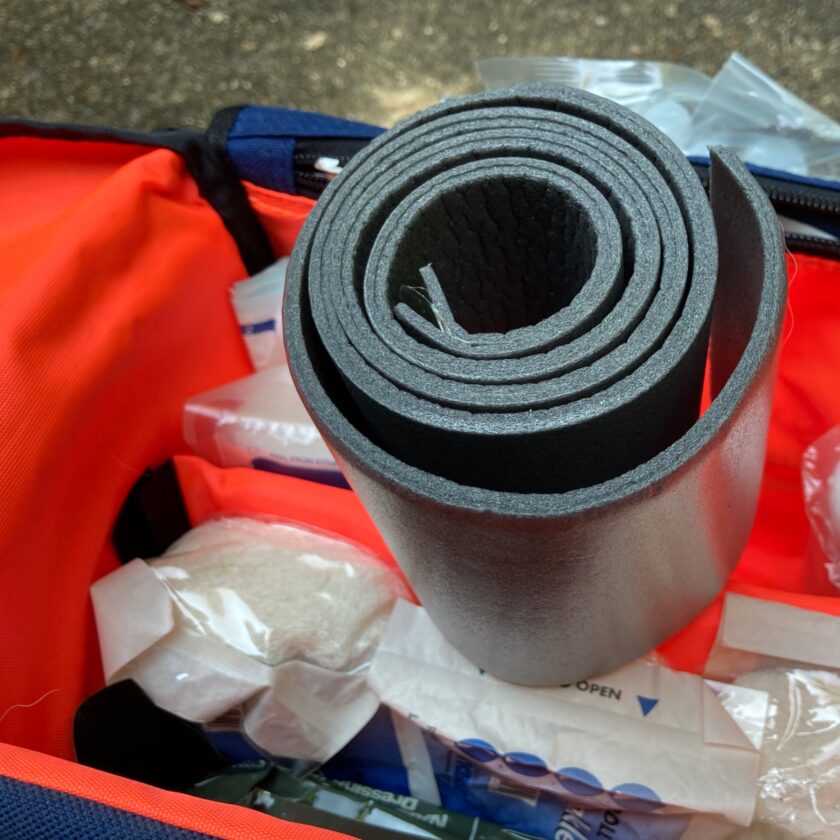
I would also recommend having a SAM Splint or two. SAM splints are amazing – they are pliable, yet rigid splinting material. They can be folded creatively to become extremely rigid, and instructions are written right there on them. In combination with a triangular bandage or two, SAM splints are incredibly versatile! They can be cut to accommodate smaller areas. They can be folded flat for efficient packing. I have one of these in my EDC/SAR pack, one in my home first aid kit, and a couple others in the house.
Burns
Burns are very complicated injuries to deal with. They create a tremendous risk of infection. Burns weep and cause dehydration, and can cause severe electrolyte imbalances. The answer for dealing with burns is definitive medical care. In the meantime, I recommend having something on hand to treat a burn temporarily. It won’t do much to heal the burn but it may provide some level of pain management and prevent infection.
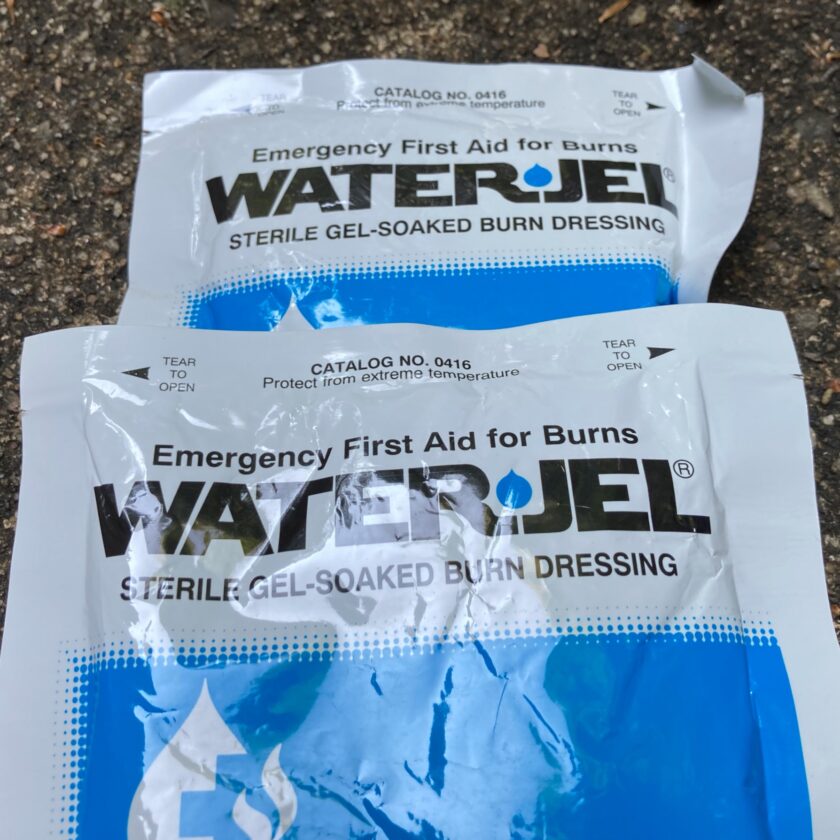
I have a couple packs of Water-Jel. Water-Jel is sterile, fluid-infused gauze. It cools the burn, and protects it from bacteria in the air. Water-Jel dressings come in a number of sizes from very large 19 x 11 sheets to 4×4 size. The ones you see in the photo here are embarrassingly out-of-date. I have ordered several more, in varying sizes. I’m sure there are competing products on the market but this is the only one I am familiar with.
Diagnostic Tools
Since this is a home kit, and since we are assuming prolonged EMS arrival times, I would definitely want some diagnostic tools at my disposal. Now…here’s the problem with these tools: unless you have training they aren’t going to do anything for you (sound familiar?). With a little bit of training these tools can tell you an awful lot about what is going on with the patient. Without an ambulance’s worth or drugs and tools you may be limited in what you can do, but I’d still rather have as much information as possible.
Stethoscope: it is hard to imagine doing any kind of medical exam without a stethoscope. Lung sounds can tell you a lot about a person’s illness and/or injury. Something as simple as crackles in the lungs can indicate that you probably need to sit that person upright. A blood pressure cuff wouldn’t be a bad thing to have, either, but I wouldn’t break the bank for it.
Thermometer: a thermometer is a great addition to a home first aid kit. If you don’t have one, I strongly recommend getting one.
Blood Glucose Meter: I also recommend having a blood glucose meter. If your family member suddenly experiences an altered level of consciousness you can quickly confirm or rule out blood sugar as a cause.
Closing Thoughts
Just a couple more thoughts on gear. First, you should have this stuff in some sort of bag. It doesn’t have to be a high-speed, modular, operator bag. The bag you see here is over 20 years old. I purchased it as volunteer firefighter and it’s held up all these years. Your bag should be organized, though. Something that allows you to say, “this is airway stuff over here, trauma here, and…” Ideally it would be brightly colored on the interior but I don’t think that’s absolutely necessary. It should be large enough to accommodate what you might need if, say, you heard your husband yelling, “help! I cut my leg with the chainsaw!” and have to run to where he is. On the other hand, it shouldn’t be cluttered. Have what you need, but not more than you need. Also, don’t store your “clinical” stuff in it, like all your OTC medications.
Secondly, keep it close at hand. I’ll admit that until recently ours has resided in the basement. I have viewed it as sort of a “preparedness” supply. Upon consideration it is now upstairs, in a convenient location that both of us know and can readily access. It’s not hidden under a bunch of clothing or coats, and it doesn’t get moved. If anything of the contents are used they are promptly replaced. Just good, basic procedures for any life-support equipment.
I have rambled on a lot about equipment. I hope the recurring them has been apparent: you need to get medical training. It’s simple, easy, and it makes us feel good to think, “I carry a tourniquet – I’m covered.” You’re covered against a very specific type of injury. But how “covered” are you if your husband suddenly clutches his chest and says, “I think I’m having a heart attack!”? How ready are you if your grandchild walks around the corner, red-faced, clutching her throat with both hands? How ready are you to provide prolonged care for a severely injured spouse?
With the very real potential for extended response times, these are questions you should be asking yourself. If the extent of your medical knowledge is predicated on being in a gunfight…you have some catching up to do.






1 thought on “Beyond the IFAK: Home Medical Gear”
Comments are closed.